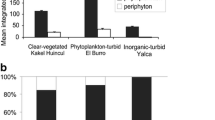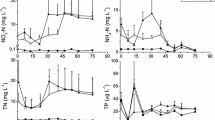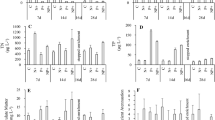Abstract
We conducted a 1-year survey in two humic shallow lakes from the floodplain of the Lower Paraná River, Laguna Grande Lake (LGL) and a relictual oxbow lake (ROL). We aimed to test two hypotheses: (1) the efficiency in light use of picoplankton (0.2–3 μm) is greater as light restriction increases and (2) the contribution of picoplankton to the total productivity is higher when the total photosynthetic biomass is lower. We performed P–E curves for picoplankton and nano- and microplankton (>3 μm) using the 14C assimilation technique. The light environments of the water bodies differed mainly owing to the development of free floating plants on the surface of the ROL and the dominance of phytoplankton in LGL. Primary productivity patterns in LGL were seasonality driven whilst in the ROL they were related to the coverage of floating macrophytes, which promoted light limitation and a lower productivity. In LGL, nano- and microplankton were in general more productive and the relative contribution of picoplankton to the total phytoplankton production decreased with the increase in total photosynthetic biomass. Hence, our study extends previously observed patterns to subtropical shallow lakes, where seasonality and free floating plants may influence the dynamics of phytoplankton production.






Similar content being viewed by others
References
Agawin, N. S., C. M. Duarte & S. Agustí, 2000. Nutrient and temperature control of the contribution of picoplankton to phytoplankton biomass and production. Limnology and Oceanography 45: 591–600.
APHA, 2005. Standard Methods for the Examination of Water and Wastewaters, 21st ed, Centennial Edition. American Public Health Association, American Water Works Association, Water Environmental Federation, Washington, DC.
Bell, T. & J. Kalff, 2001. The contribution of picophytoplankton in marine and freshwater systems of different trophic status and depth. Limnology and Oceanography 46: 1243–1248.
Belykh, O. I., G. Ekaterina, T. Sorokovikova, A. Saphonova & I. Tikhonova, 2006. Autotrophic picoplankton of Lake Baikal: composition, abundance and structure. Hydrobiologia 568: 9–17.
Callieri, C. & J. Stockner, 2002. Freshwater autotrophic picoplankton: a review. Journal of Limnology 61: 1–14.
Callieri, C., S. Moro, E. Caravati, N. D. Crosbie & T. Weisse, 2005. Strain-specific photosynthetic response of freshwater picocyanobacteria. Verhandlungen Internationale Vereinigung für Theoretische und Angewandte Limnologie 29: 777–782.
Callieri, C., B. Modenutti, C. Queimaliños, R. Bertoni & E. Balseiro, 2007. Production and biomass of picophytoplankton and larger autotrophs in Andean ultraoligotrophic lakes: differences in light harvesting efficiency in deep layers. Aquatic Ecology 41: 511–523.
Carrick, H. J., F. J. Alridge & C. L. Schelske, 1993. Wind influences phytoplankton biomass and composition in a shallow, productive lake. Limnology and Oceanography 38: 1179–1182.
Drakare, S., P. Blomqvist, A.-K. Bergström & M. Jansson, 2003. Relationship between picophytoplankton and environmental variables in lakes along a gradient of water colour and nutrient content. Freshwater Biology 48: 729–740.
Eilers, P. H. C. & J. C. H. Peeters, 1988. A model for the relationship between light intensity and the rate of photosynthesis in phytoplankton. Ecological Modelling 42: 199–215.
Falkowski, P. G., 1981. Light-shade adaptations and assimilation numbers. Journal of Plankton Research 3: 203–216.
Fogg, G. E., 1986. Picoplankton. Proceedings of the Royal Society of London Series B 228: 1–30.
Greisberger, S., M. T. Dokullil & K. Teubner, 2008. A comparison of phytoplankton size-fractions in Mondsee, an alpine lake in Austria: distribution, pigment composition and primary production rates. Aquatic Ecology 42: 379–389.
Helbling, E. W., V. E. Villafañe & E. S. Barbieri, 2001a. Sensitivity of winter phytoplankton communities from Andean lakes to artificial ultraviolet-B radiation. Revista Chilena de Historia Natural 74: 273–282.
Helbling, E. W., A. G. J. Buma, M. K. de Boer & V. E. Villafañe, 2001b. In situ impact of solar ultraviolet radiation on photosynthesis and DNA in temperate marine phytoplankton. Marine Ecology Progress Series 211: 43–49.
Holm-Hansen, O. & E. W. Helbling, 1995. Técnicas para la medición de la productividad primaria en el fitoplancton. In Alveal, K., M. E. Ferrario, E. C. Oliveira & E. Sar (eds), Manual de métodos ficológicos. Universidad de Concepción, Concepción, Chile: 329–350.
Irwin, A. J., Z. V. Finkel, O. M. Schofield & P. G. Falkowski, 2006. Scaling-up from nutrient physiology to the size-structure of phytoplankton communities. Journal of Plankton Research 28: 459–471.
Izaguirre, I., H. Pizarro, P. de Tezanos Pinto, P. Rodríguez, I. O′Farrell, F. Unrein & J. Gasol, 2010. Macrophyte influence on the structure and productivity of photosynthetic picoplankton in wetlands. Journal of Plankton Research 32: 221–238.
Jasser, I., 1997. The dynamics and importance of picoplankton in shallow, dystrophic lake in comparison with surface waters of two deep lakes with contrasting trophic status. Hydrobiologia 342(343): 87–93.
Kirk, J. T. O., 2011. Light and photosynthesis in aquatic ecosystems, 3rd ed. Cambridge University Press, Cambridge.
Malinsky-Rushansky, N., T. Berman & Z. Dubinsky, 1997. Seasonal photosynthetic activity of autotrophic picoplankton in Lake Kinneret, Israel. Journal of Plankton Research 19: 979–993.
McBride, G. B., 1992. Simple calculation of daily photosynthesis by means of five photosynthesis-light equations. Limnology and Oceanography 37: 1796–1808.
Mózes, A., M. Présing & L. Vörös, 2006. Seasonal dynamics of picocyanobacteria and picoeukaryotes in a large shallow lake (Lake Balaton, Hungary). International Review of Hydrobiology 91: 38–50.
Neale, P., J. F. Talling, S. I. Heaney, C. S. Reynolds & J. W. Lund, 1991. Long time series from the English Lake District: irradiance-dependent phytoplankton dynamics during the spring maximum. Limnology and Oceanography 36: 751–760.
Nusch, E., 1980. Comparison of different methods for chlorophyll and phaeopigment determination. Archiv für Hydrobiologie Ergebnisse der Limnologie 14: 14–36.
O'Farrell, I., P. de Tezanos Pinto, P. Rodríguez, G. Chaparro & H. Pizarro, 2009. Experimental evidence of the dynamic effect of free-floating plants on phytoplankton ecology. Freshwater Biology 54: 363–375.
O’Farrell, I., I. Izaguirre, G. Chaparro, F. Unrein, R. Sinistro, H. Pizarro, P. Rodríguez, P. de Tezanos Pinto, R. Lombardo & G. Tell, 2011. Water level as the main driver of the alternation between a free-floating plant and a phytoplankton dominated state: a long-term study in a floodplain lake. Aquatic Sciences 73: 275–287.
Raven, J. A., 1998. The twelfth Tansley Lecture. Small is beautiful: the picophytoplankton. Functional Ecology 12: 503–513.
Reynolds, C. S. (ed.), 1984. The Ecology of Freshwater Phytoplankton. Cambridge University Press, London.
Rodríguez, P. & H. Pizarro, 2007. Phytoplankton productivity in a highly colored shallow lake of a South American floodplain. Wetlands 24: 1153–1160.
Sakshaug, E., A. Bricaud, Y. Dandonneau, P. G. Falkowski, D. A. Kiefer, L. Legendre, A. Morel, J. Parslow & M. Takahashi, 1997. Parameters of photosynthesis: definitions, theory and interpretation of results. Journal of Plankton Research 19: 1637–1670.
Schallenberg, M. & C. Burns, 2004. Effects of sediment resuspension on phytoplankton production: testing apart the influences of light, nutrients and algal entrainment. Freshwater Biology 49: 143–159.
Schweizer, A. & R. E. Heusel, 1992. Picoplankton photosynthesis and diurnal variations in photosynthesis-irradiance relationship in a eutrophic and meso-oligotrophic lake. Hydrobiologia 238: 131–138.
Sinistro, R., I. Izaguirre & V. Asikian, 2006. Experimental study on the microbial plankton community in a South American wetland (Lower Paraná River Basin) and the effect of the light deficiency due to floating macrophytes. Journal of Plankton Research 28: 753–768.
Sinistro, R., M. L. Sánchez, M. C. Marinone & I. Izaguirre, 2007. Experimental study of the zooplankton impact on the trophic structure of phytoplankton and the microbial assemblages in a temperate wetland (Argentina). Limnologica 37: 88–99.
Steitz, A. & B. Velimirov, 1999. Contribution of picocyanobacteria to total primary production and community respiratory losses in a backwater system. Journal of Plankton Research 21: 2341–2360.
Stockner, J., 1988. Phototrophic picoplankton: an overview from marine and freshwater ecosystems. Limnology and Oceanography 33: 765–775.
Stockner, J. & N. Antia, 1986. Algal picoplankton from marine and freshwater: a multidisciplinary perspective. Canadian Journal of Fisheries and Aquatic Sciences 43: 2472–2503.
Stumm, W. & J. Morgan, 1996. Aquatic Chemistry. Chemical Equilibria and Rates in Natural Waters. Wiley, New York.
Utermöhl, M., 1958. Zur Vervollkommung der quantitativen Phytoplankton Methodik. Verhandlungen Internationale Vereinigung für Theoretische und Angewandte Limnologie 9: 1–38.
Vörös, L., P. Gulyás & J. Németh, 1991. Occurrence, dynamics and production of picoplankton in Hungarian shallow lakes. International Revue Ges Hydrobiologie 76: 617–629.
Williamsom, C., D. P. Morris, M. L. Pace & O. G. Olson, 1999. Dissolved organic carbon and nutrients as regulators of lake ecosystems: resurrection of a more integrated paradigm. Limnology and Oceanography 44: 795–803.
Zar, J., 1996. Biostatical Analysis, 3rd ed. Prentice-Hall, Englewood Cliffs, NJ.
Acknowledgments
We thank our colleagues at the laboratory of Limnology (Universidad de Buenos Aires, Argentina) for the field assistance and the personnel of the Natural Reserve Otamendi (Administración de Parques Nacionales, Buenos Aires, Argentina) for their technical support. Also, to two anonymous reviewers and Dr. Luigi Naselli-Flores (Associate Editor), whose comments helped to improve the manuscript. This work was supported by Universidad de Buenos Aires (Grant UBACyT-X815), ANPCyT (Grant PICT 536 and 12332) and CONICET (Grant PIP 64).
Author information
Authors and Affiliations
Corresponding author
Additional information
Handling editor: Luigi Naselli-Flores
Rights and permissions
About this article
Cite this article
Rodríguez, P., Pizarro, H. & Vera, M.S. Size fractionated phytoplankton production in two humic shallow lakes with contrasting coverage of free floating plants. Hydrobiologia 691, 285–298 (2012). https://doi.org/10.1007/s10750-012-1081-5
Received:
Revised:
Accepted:
Published:
Issue Date:
DOI: https://doi.org/10.1007/s10750-012-1081-5




